Evaluation of Surface Data Simulation Performance with the Brazilian Global Atmospheric Model (BAM)
Abstract
:1. Introduction
2. Materials and Methods
2.1. Region of Study
2.2. Observed Data
2.2.1. Temperature
2.2.2. Solar Radiation and Wind Speed
2.3. BAM v.2.2.1 Experimental Design
2.4. Methodology for Intercomparison
3. Results
3.1. Description of Present Climatology
3.2. Comparison between Model and Observations on the Different Timescales
3.3. PDF Analysis
4. Discussion
5. Conclusions
Supplementary Materials
Author Contributions
Funding
Institutional Review Board Statement
Informed Consent Statement
Data Availability Statement
Acknowledgments
Conflicts of Interest
References
- Marchezini, V.; Londe, L.R.; Loose, E.B.; Saito, S.M.; Marengo, J.A. Perceptions About Climate Change in the Brazilian Civil Defense Sector. Int. J. Disaster Risk Sci. 2022, 13, 664–674. [Google Scholar] [CrossRef]
- Pes, M.P.; Pereira, E.B.; Marengo, J.A.; Martins, F.R.; Heinemann, D.; Schmidt, M. Climate trends on the extreme winds in Brazil. Renew. Energy 2017, 109, 110–120. [Google Scholar] [CrossRef]
- Lucas, E.W.M.; dos Santos Silva, F.D.; de Souza, F.d.A.S.; Pinto, D.D.C.; Gomes, H.B.; Gomes, H.B.; Lins, M.C.C.; Herdies, D.L. Regionalization of Climate Change Simulations for the Assessment of Impacts on Precipitation, Flow Rate and Electricity Generation in the Xingu River Basin in the Brazilian Amazon. Energies 2022, 15, 7698. [Google Scholar] [CrossRef]
- Freitas, A.A.; Drumond, A.; Carvalho, V.S.B.; Reboita, M.S.; Silva, B.C.; Uvo, C.B. Drought Assessment in São Francisco River Basin, Brazil: Characterization through SPI and Associated Anomalous Climate Patterns. Atmosphere 2022, 13, 41. [Google Scholar] [CrossRef]
- Porfirio, A.C.S.; Ceballos, J.C.; Britto, J.M.S.; Costa, S.M.S. Evaluation of Global Solar Irradiance Estimates from GL1.2 Satellite-Based Model over Brazil Using an Extended Radiometric Network. Remote Sens. 2020, 12, 1331. [Google Scholar] [CrossRef] [Green Version]
- Figueroa, S.N.; Bonatti, J.P.; Kubota, P.Y.; Grell, G.A.; Morrison, H.; Barros, S.R.M.; Fernandez, J.P.R.; Ramirez, E.; Siqueira, L.; Luzia, G.; et al. The Brazilian Global Atmospheric Model (BAM): Performance for Tropical Precipitation Forecasting and Sen-sitivity to Convective Scheme and Horizontal Resolution. Weather Forecast. 2016, 31, 1547–1572. [Google Scholar] [CrossRef]
- Escada, P.; Coelho, C.A.S.; Taddei, R.; Dessai, S.; Cavalcanti, I.F.A.; Donato, R.; Kayano, M.T.; Martins, E.S.P.R.; Miguel, J.C.H.; Monteiro, M.; et al. Climate services in Brazil: Past, present, and future perspectives. Clim. Serv. 2021, 24, 100276. [Google Scholar] [CrossRef]
- Coelho, C.A.S.; Souza, D.C.; Kubota, P.Y.; Costa, S.M.S.; Menezes, L.; Guimarães, B.S.; Figueroa, S.N.; Bonatti, J.P.; Cavalcanti, I.F.A.; Sampaio, G.; et al. Evaluation of climate simulations produced with the Brazilian global atmospheric model version 1.2. Clim. Dyn. 2021, 56, 873–898. [Google Scholar] [CrossRef]
- Schultz, M.G.; Stadler, S.; Schröder, S.; Taraborrelli, D.; Franco, B.; Krefting, J.; Henrot, A.; Ferrachat, S.; Lohmann, U.; Neubauer, D.; et al. The chemistry–climate model ECHAM6.3-HAM2.3-MOZ1.0. Geosci. Model Dev. 2018, 11, 1695–1723. [Google Scholar] [CrossRef] [Green Version]
- Pezza, A.; Sadler, K.; Uotila, P.; Vihma, T.; Mesquita, M.D.S.; Reid, P. Southern Hemisphere strong polar mesoscale cyclones in high-resolution datasets. Clim. Dyn. 2016, 47, 1647–1660. [Google Scholar] [CrossRef]
- Nigro, M.A.; Cassano, J.J.; Wille, J.; Bromwich, D.H.; Lazzara, M.A. A self-organizing-map-based evaluation of the Antarctic mesoscale prediction system using observations from a 30-m instrumented tower on the Ross Ice Shelf, Antarctica. Weather Forecast. 2017, 32, 223–242. [Google Scholar] [CrossRef]
- Hines, K.M.; Bromwich, D.H.; Wang, S.-H.; Silber, I.; Verlinde, J.; Lubin, D. Microphysics of summer clouds in central West Antarctica simulated by the Polar Weather Research and Forecasting Model (WRF) and the Antarctic Mesoscale Prediction System (AMPS). Atmos. Chem. Phys. 2019, 19, 12431–12454. [Google Scholar] [CrossRef] [Green Version]
- Bromwich, D.H.; Otieno, F.O.; Hines, K.M.; Manning, K.W.; Shilo, E. Comprehensive evaluation of polar weather research and forecasting model performance in the Antarctic. J. Geophys. Res. Atmos. 2013, 118, 274–292. [Google Scholar] [CrossRef] [Green Version]
- Cavalcanti, I.F.A.; Raia, A. Lifecycle of South American monsoon system simulated by CPTEC/INPE AGCM. Int. J. Climatol. 2017, 37, 878–896. [Google Scholar] [CrossRef]
- Cavalcanti, I.F.A.; Silveira, V.P.; Figueroa, S.N.; Kubota, P.Y.; Bonatti, J.P.; de Souza, D.C. Climate variability over South America—Regional and large scale features simulated by the Brazilian Atmospheric Model (BAM-v0). Int. J. Climatol. 2020, 40, 2845–2869. [Google Scholar] [CrossRef]
- Guimarães, B.S.; Coelho, C.A.S.; Woolnough, S.J.; Kubota, P.Y.; Bastarz, C.F.; Figueroa, S.N.; Bonatti, J.P.; de Souza, D.C. Configuration and hindcast quality assessment of a Brazilian global sub-seasonal prediction system. Q. J. R. Meteorol. Soc. 2020, 146, 1067–1084. [Google Scholar] [CrossRef]
- Coelho, C.A.S.; de Souza, D.C.; Kubota, P.Y.; Cavalcanti, I.F.A.; Baker, J.C.A.; Figueroa, S.N.; Firpo, M.A.F.; Guimaraes, B.S.; Costa, S.M.S.; Gonçalves, L.J.M.; et al. Assessing the representation of South American monsoon features in Brazil and UK climate model simulations. Clim. Resil. Sustain. 2021, 1, e27. [Google Scholar]
- Guimarães, B.S.; Coelho, C.A.S.; Woolnough, S.J.; Kubota, P.Y.; Bastarz, C.F.; Figueroa, S.N.; Bonatti, J.P.; de Souza, D.C. An inter-comparison performance assessment of a Brazilian global sub-seasonal prediction model against four sub-seasonal to seasonal (S2S) prediction project models. Clim. Dyn. 2021, 56, 2359–2375. [Google Scholar] [CrossRef]
- Baker, J.C.A.; de Souza, D.C.; Kubota, P.Y.; Buermann, W.; Coelho, C.A.S.; Andrews, M.B.; Gloor, M.; Garcia-Carreras, L.; Figueroa, S.N.; Spracklen, D.V. An assessment of land–atmosphere interactions over South America using satellites, reanalysis, and two global climate models. J. Hydrometeorol. 2021, 22, 905–922. [Google Scholar] [CrossRef]
- Cavalcanti, I.F.A.; Souza, D.C.; Kubota, P.Y.; Coelho, C.A.S.; Figueroa, S.N.; Baker, J.C.A. The global monsoon system representation in BAM-v1.2 and HadGEM3 climate simulations. Int. J. Climatol. 2022, 42, 8089–8111. [Google Scholar] [CrossRef]
- Xavier, A.C.; Scanlon, B.R.; King, C.W.; Alves, A.I. New improved Brazilian daily weather gridded data (1961–2020). Int. J. Climatol. 2022, 42, 8390–8404. [Google Scholar] [CrossRef]
- Danielsom, J.; Gesch, D. Global Multi-Resolution Terrain Elevation Data 2010 (GMTED2010). USGS 2011. Available online: https://pubs.usgs.gov/of/2011/1073/pdf/of2011-1073.pdf (accessed on 20 November 2022).
- Xavier, A.C.; King, C.W.; Scanlon, B.R. Daily gridded meteorological variables in brazil (1980–2013). Int. J. Climatol. 2016, 36, 2644–2659. [Google Scholar] [CrossRef] [Green Version]
- Hersbach, H.; de Rosnay, P.; Bell, B.; Schepers, D.; Simmons, A.; Soci, C.; Abdalla, S.; Balmaseda, M.A.; Balsamo, G.; Bechtold, P.; et al. Operational Global Reanalysis: Progress, Future Directions and Synergies with NWP. ERA Rep. Ser. 2018, 27, 1–65. Available online: https://www.ecmwf.int/node/18765 (accessed on 20 November 2022).
- Hersbach, H.; Bell, W.; Berrisford, P.; Horányi, A.; Muñoz-Sabater, J.; Nicolas, J.; Radu, R.; Schepers, D.; Simmons, A.; Soci, C.; et al. Global reanalysis: Goodbye ERA-Interim, hello ERA5. ECMWF Newsl. 2019, 159, 17–24. [Google Scholar]
- Reynolds, R.W.; Rayner, N.A.; Smith, T.M.; Stokes, D.C.; Wang, W. An improved in situ and satellite SST analysis for climate. J. Clim. 2002, 15, 1609–1625. [Google Scholar] [CrossRef]
- Willmott, C.J.; Ackleson, S.G.; Davis, R.E.; Feddema, J.J.; Klink, K.M.; Legates, D.R.; O’Donnell, J.; Rowe, C.M. Statistics for the evaluation and comparison of models. J. Geophys. Res. 1985, 90, 8995–9005. [Google Scholar] [CrossRef] [Green Version]
- Morrison, H.; Pinto, J.O. Mesoscale modeling of springtime arctic mixed-phase clouds using a new two-moment bulk microphysics scheme. J. Atmos. Sci. 2005, 62, 3683–3704. [Google Scholar] [CrossRef]
- Morrison, H.; Thompson, G.; Tatarskii, V. Impact of cloud microphysics on the development of trailing stratiform precipitation in a simulated squall line: Comparison of one-and two-moment schemes. Mon. Weather Rev. 2009, 137, 991–1007. [Google Scholar] [CrossRef] [Green Version]
- Chou, M.; Suarez, M.J. A Solar Radiation Parameterization (CLIRAD-SW) for Atmospheric Studies; NASA Technical Memorandum, v. 10460; NASA: Washington, DC, USA, 1999.
- Tarasova, T.A.; Fomin, B.A. Solar radiation absorption due to water vapor: Advanced broadband parameterizations. J. Appl. Meteorol. 2000, 39, 1947–1951. [Google Scholar] [CrossRef]
- Chou, M.D.; Suarez, M.J.; Liang, X.Z.; Yan, M.M.; Cote, C. A Thermal Infrared Radiation Parameterization for Atmospheric Studies. NASA/TM-2001-104606 2001, Volume 19. Available online: https://ntrs.nasa.gov/citations/20010072848 (accessed on 20 November 2022).
- Bretherton, C.S.; Park, S. A new moist turbulence parameterization in the Community Atmosphere Model. J. Clim. 2009, 22, 3422–3448. [Google Scholar] [CrossRef]
- Han, J.; Pan, H. Revision of convection and vertical diffusion schemes in the NCEP global forecast system. Weather Forecast. 2011, 26, 520–533. [Google Scholar] [CrossRef]
- Yu, H.; Kaufman, Y.J.; Chin, M.; Feingold, G.; Remer, L.A.; Anderson, T.L.; Balkanski, Y.; Bellouin, N.; Boucher, O.; Christopher, S.; et al. A review of measurement-based assessments of the aerosol direct radiative effect and forcing. Atmos. Chem. Phys. 2006, 6, 613–666. [Google Scholar] [CrossRef] [Green Version]
- Rio, C.; Hourdin, F. A thermal plume model for the convective boundary layer: Representation of cumulus clouds. J. Atmos. Sci. 2008, 65, 407–425. [Google Scholar] [CrossRef]
- Webster, S.; Brown, A.R.; Cameron, D.R.; Jones, C.P. Improvements to the representation of orography in the Met Office Unified Model. Q. J. R. Meteorol. Soc. 2003, 129, 1989–2010. [Google Scholar] [CrossRef]
- Costa, R.L.; Gomes, H.B.; Pinto, D.D.C.; da Rocha Júnior, R.L.; dos Santos Silva, F.D.; Gomes, H.B.; da Silva, M.C.L.; Herdies, D.L. Gap Filling and Quality Control Applied to Meteorological Variables Measured in the Northeast Region of Brazil. Atmosphere 2021, 12, 1278. [Google Scholar] [CrossRef]
- Aguilar, E.; Peterson, T.C.; Obando, P.R.; Frutos, R.; Retana, J.A.; Solera, M.; Soley, J.; Garcıa, I.G.; Araujo, R.M.; Santos, A.R.; et al. Changes in precipitation and temperature extremes in Central America and northern South America, 1961–2003. J. Geophys. Res. 2005, 110, D2310. [Google Scholar] [CrossRef]
- Vincent, L.A.; Peterson, T.C.; Barros, V.R.; Marino, M.B.; Rusticucci, M.; Carrasco, G.; Ramirez, E.; Alves, L.M.; Ambrizzi, T.; Berlato, M.A.; et al. Observed trends in indices of daily temperature extremes in South America 1960–2000. J. Clim. 2005, 18, 5011–5023. [Google Scholar] [CrossRef]
- Alexander, L.V.; Zhang, X.; Peterson, T.C.; Caesar, J.; Gleason, B.; Tank, A.M.G.K.; Haylock, M.; Collins, D.; Trewin, B.; Rahimzadeh, F.; et al. Global observed changes in daily climate extremes of temperature and precipitation. J. Geophys. Res 2006, 111, D05109. [Google Scholar] [CrossRef] [Green Version]
- Haylock, M.R.; Peterson, T.C.; Alves, L.M.; Ambrizzi, T.; Anunciaçao, Y.M.T.; Baez, J.; Barros, V.R.; Berlato, M.A.; Bidegain, M.; Coronel, G.; et al. Trends in total and extreme South American rainfall in 1960–2000 and links with sea surface temperature. J. Clim 2006, 19, 1490–1512. [Google Scholar] [CrossRef]
- Skansi, M.; Brunet, M.; Sigro, J.; Aguilar, E.; Groening, J.A.A.; Bentancur, O.J.; Geier, Y.R.C.; Amaya, R.L.C.; Jacome, H.; Ramos, A.M.; et al. Warming and wetting signals emerging from analysis of changes in climate extreme indices over South America. Glob. Planet. Chang. 2013, 100, 295–307. [Google Scholar] [CrossRef]
- Bezerra, B.G.; Silva, L.L.; e Silva, C.M.S.; Carvalho, G.G. Changes of precipitation extremes indices in Sao Francisco River basin, Brazil from 1947 to 2012. Theor. Appl. Climatol. 2019, 135, 565–576. [Google Scholar] [CrossRef]
- Costa, R.L.; Baptista, G.M.M.; Gomes, H.B.; Silva, F.D.S.; da Rocha Júnior, R.L.; Salvador, M.A.; Herdies, D.L. Analysis of climate extremes indices over northeast Brazil from 1961 to 2014. Weather Clim. Extrem. 2020, 28, 100254. [Google Scholar] [CrossRef]
- Lima, C.I.S.; dos Santos Silva, F.D.; Freitas, I.G.F.; Pinto, D.D.C.; Costa, R.L.; Gomes, H.B.; Silva, E.H.L.; Silva, L.L.; Silva, V.P.R.; Silva, B.K.N. Método Alternativo de Zoneamento Agroclimático do Milho para o Estado de Alagoas. Rev. Bras. Meteorol. 2021, 35, 1057–1067. [Google Scholar] [CrossRef]
- Dos Santos Silva, F.D.; Costa, R.L.; da Rocha Júnior, R.L.; Gomes, H.B.; de Azevedo, P.V.; da Silva, V.d.P.R.; Monteiro, L.A. Cenários Climáticos e Produtividade do Algodão no Nordeste do Brasil. Parte II: Simulação Para 2020 a 2080. Rev. Bras. Meteorol. 2020, 35, 913–929. [Google Scholar] [CrossRef]
- Oliveira, L.P.M.; dos Santos Silva, F.D.; Costa, R.L.; da Rocha Júnior, R.L.; Barros Gomes, H.; Pereira, M.P.S.; Monteiro, L.A.; Rodrigues da Silva, V.d.P. Impacto das Mudanças Climáticas na Produtividade da Cana de Açúcar em Maceió. Rev. Bras. Meteorol. 2020, 35, 969–980. [Google Scholar] [CrossRef]
- Kane, R.P. Prediction of droughts in Northeast Brazil: Role of ENSO and use of periodicities. Int. J. Climatol. 1997, 17, 655–665. [Google Scholar] [CrossRef]
- Hastenrath, S. Circulation and teleconnection mechanisms of Northeast Brazil droughts. Prog. Oceanogr. 2006, 70, 407–415. [Google Scholar] [CrossRef]
- Shimizu, M.H.; Ambrizzi, T.; Liebmann, B. Extreme precipitation events and their relationship with ENSO and MJO phases over northern South America. Int. J. Climatol. 2017, 37, 2977–2989. [Google Scholar] [CrossRef]
- Marengo, J.A.; Alves, L.M.; Alvalá, R.C.; Cunha, A.P.; Brito, S.; Moraes, O.L. Climatic characteristics of the 2010–2016 drought in the semiarid Northeast Brazil region. An. Acad. Bras. Cienc. 2017, 90, 1973–1985. [Google Scholar] [CrossRef]
- Da Rocha Júnior, R.L.; Pinto, D.D.C.; dos Santos Silva, F.D.; Gomes, H.B.; Gomes, H.B.; Costa, R.L.; Pereira, M.P.S.; Peña, M.; dos Santos Coelho, C.A.; Herdies, D.L. An Empirical Seasonal Rainfall Forecasting Model for the Northeast Region of Brazil. Water 2021, 13, 1613. [Google Scholar] [CrossRef]
- Gomes, H.B.; da Silva, M.C.L.; Barbosa, H.d.M.J.; Ambrizzi, T.; Baltaci, H.; Gomes, H.B.; Silva, F.D.d.S.; Costa, R.L.; Figueroa, S.N.; Herdies, D.L.; et al. WRF Sensitivity for Seasonal Climate Simulations of Precipitation Fields on the CORDEX South America Domain. Atmosphere 2022, 13, 107. [Google Scholar] [CrossRef]
- Michot, V.; Vila, D.; Arvor, D.; Corpetti, T.; Ronchail, J.; Funatsu, B.M.; Dubreuil, V. Performance of TRMM TMPA 3B42 V7 in Replicating Daily Precipitation and Regional Precipitation Regimes in the Amazon Basin (1998–2013). Remote Sens. 2018, 10, 1879. [Google Scholar] [CrossRef] [Green Version]
- Demirtas, M.; Nance, L.; Barnardet, L.; Lin, Y.; Chuang, H.-Y.; Loughe, A.; Mahoney, J.; Gall, R.; Koch, S. The Developmental Testbed Center Verification System; WRF/MM5 Users’ Workshop; NCAR: Boulder, CO, USA, 2005.
- Rodrigues, D.T.; Silva, C.M.S.; Reis, J.S.; Palharini, R.S.A.; Júnior, J.B.C.; Silva, H.J.F.; Mutti, P.R.; Bezerra, B.G.; Gonçalves, W.A. Evaluation of the Integrated Multi-SatellitE Retrievals for the Global Precipitation Measurement (IMERG) Product in the São Francisco Basin (Brazil). Water 2021, 13, 2714. [Google Scholar] [CrossRef]
- Costa, R.L.; Gomes, H.B.; Silva, F.D.S.; Baptista, G.M.M.; da Rocha Júnior, R.L.; Herdies, R.L.; da Silva, V.P.R. Climate Change Scenarios for the Northeast Region of Brazil through the Statistical Downscaling Technique. Rev. Bras. Meteorol. 2020, 35, 785–801. [Google Scholar] [CrossRef]
- Moura, R.G.; Correia, F.W.S.; Veiga, J.A.P.; Capistrano, V.B.; Kubota, P.Y. Avaliação do Brazilian Global Atmospheric Model na Simulação dos Componentes do Balanço de Água na Bacia Amazônica. Rev. Bras. Meteorol. 2021, 36, 23–37. [Google Scholar]
- Baker, J.C.A.; Spracklen, D.V. Divergent representation of precipitation recycling in the Amazon and Congo in CMIP6 models. Geophys. Res. Lett. 2022, 49, e2021GL095136. [Google Scholar] [CrossRef] [PubMed]
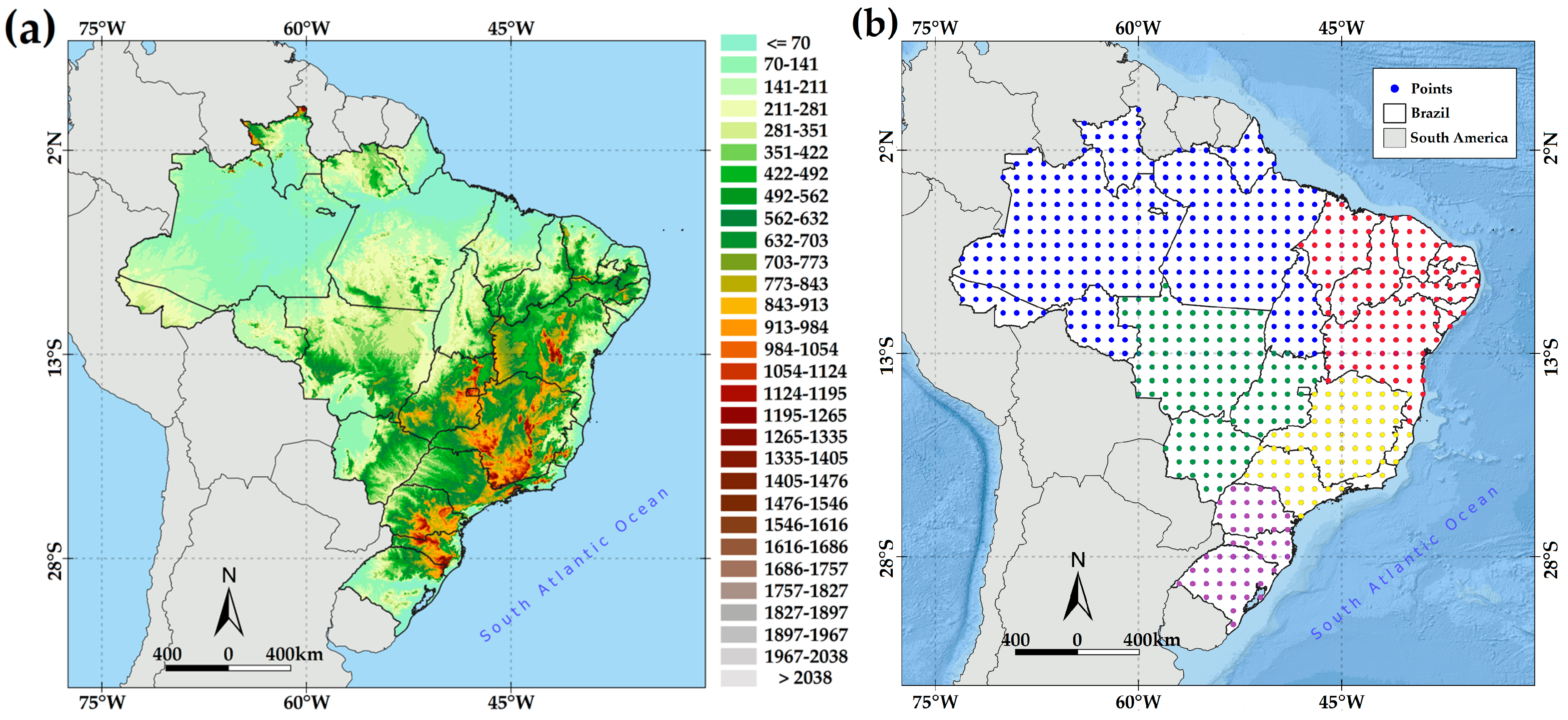

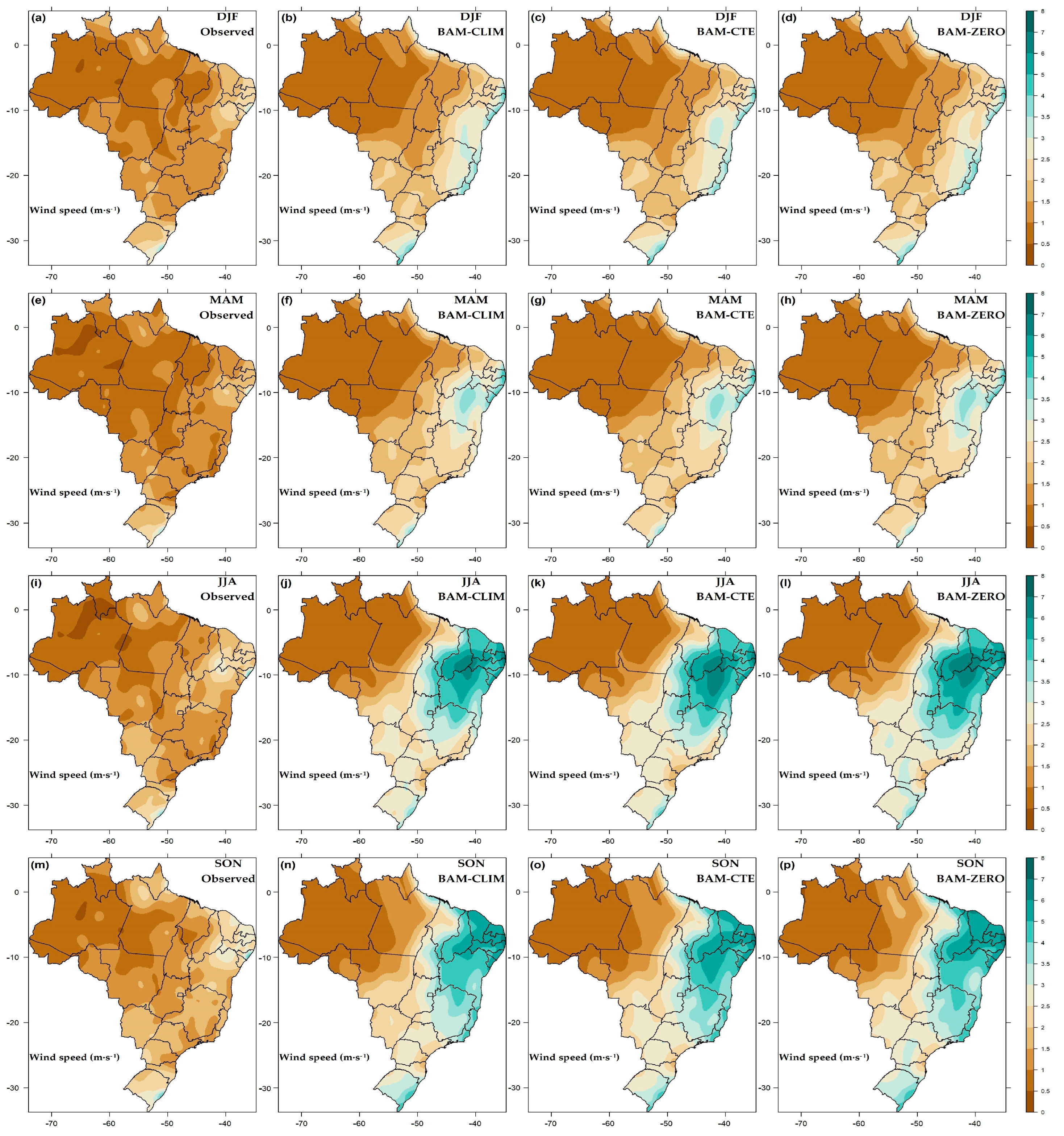
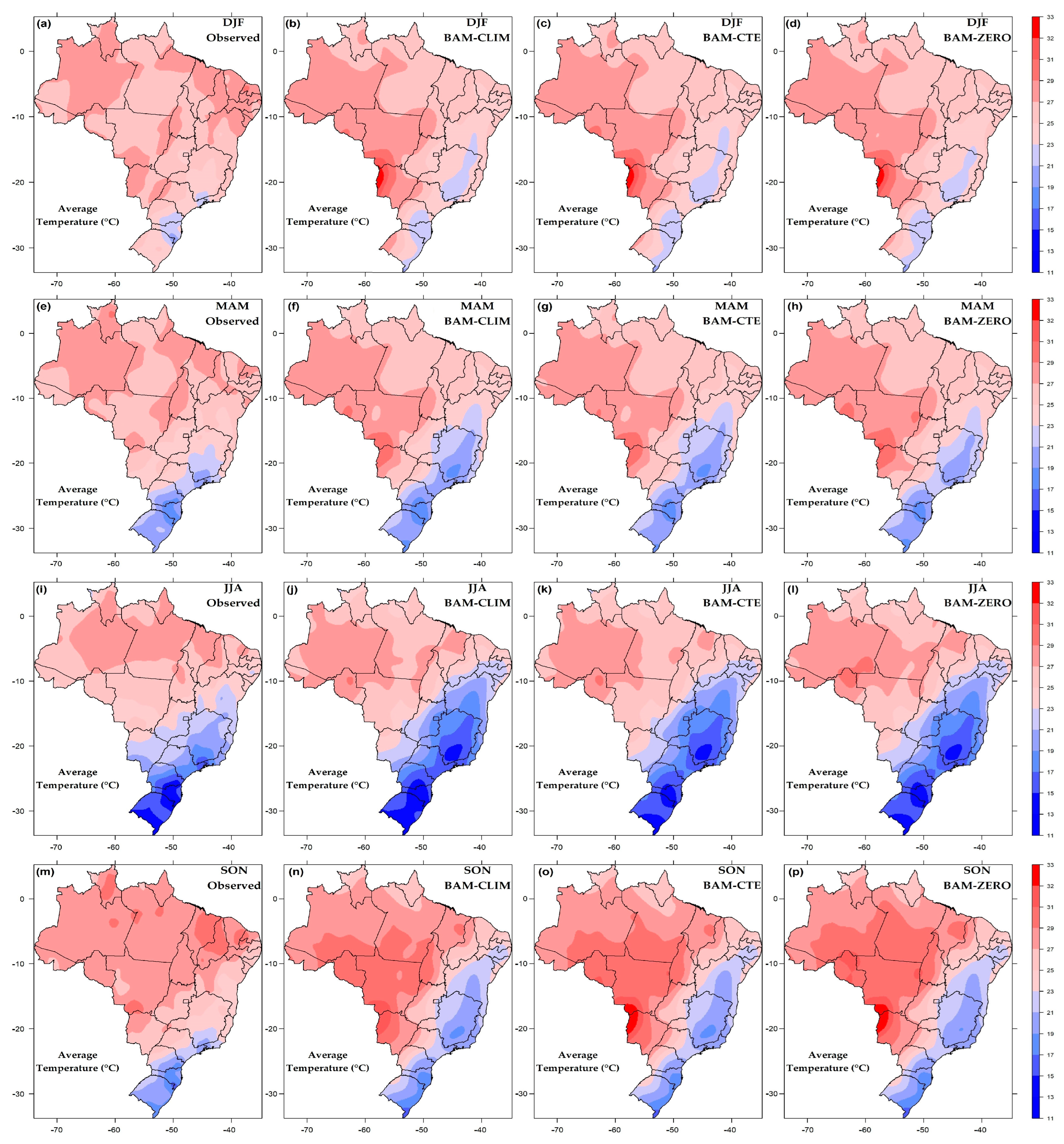

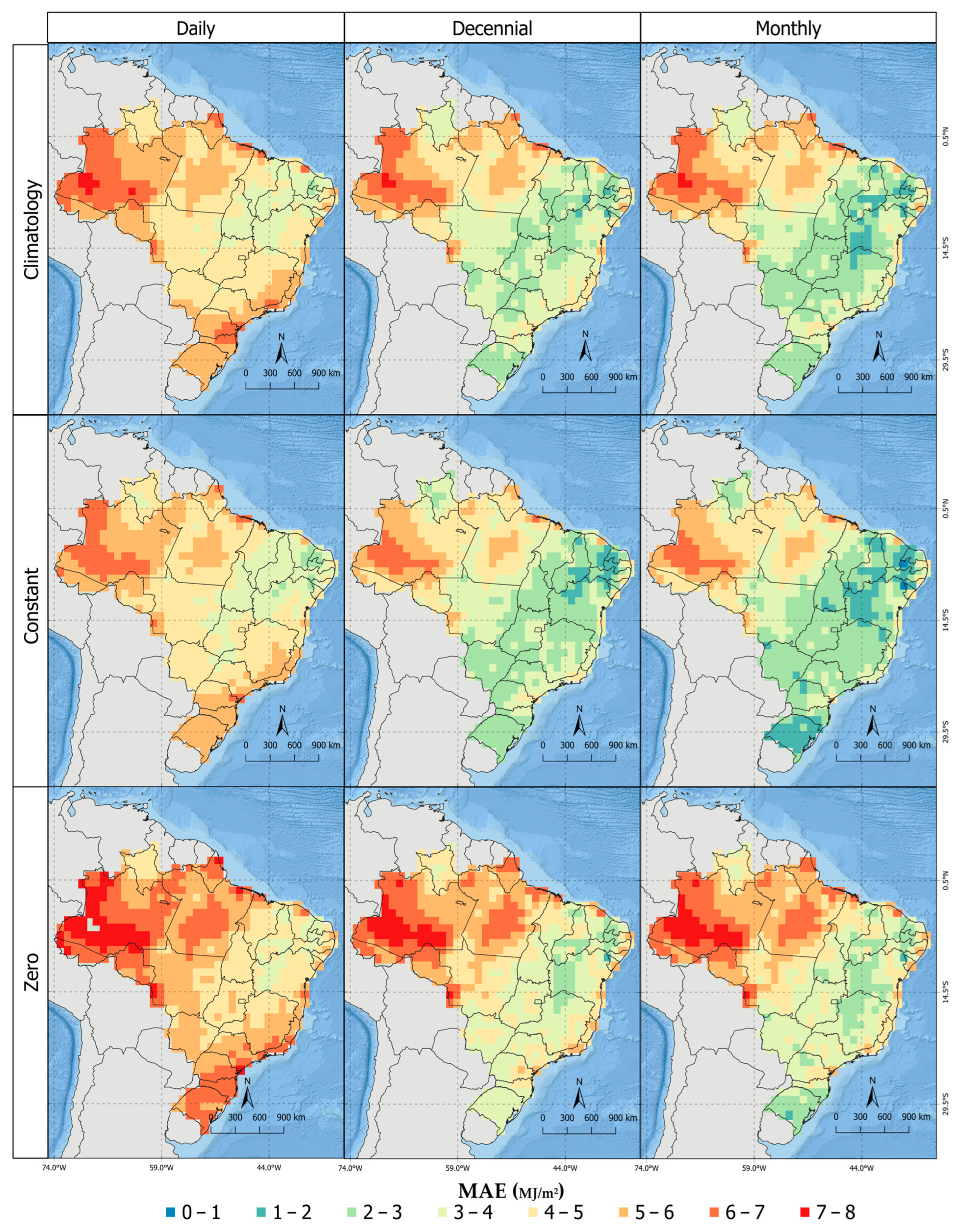
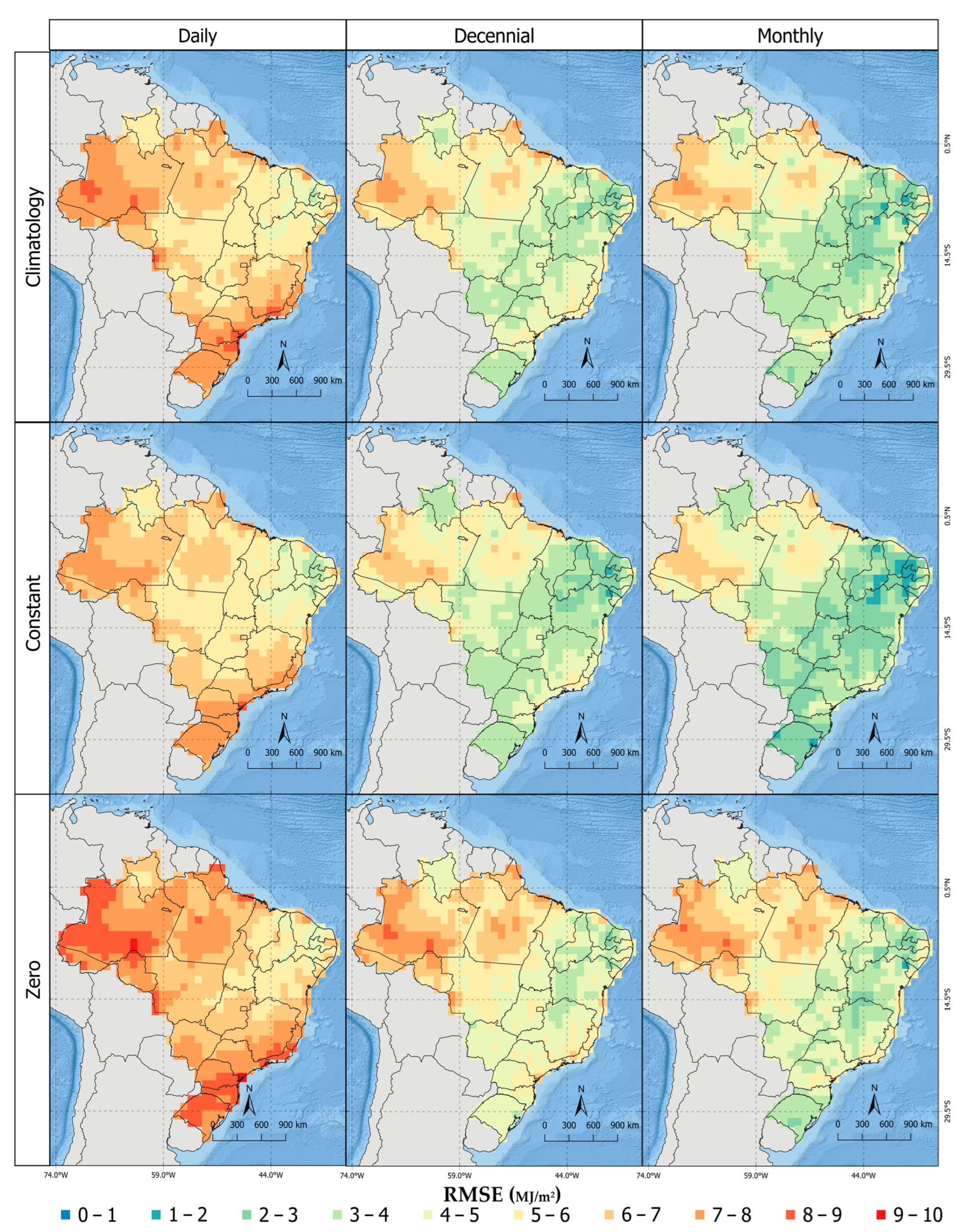



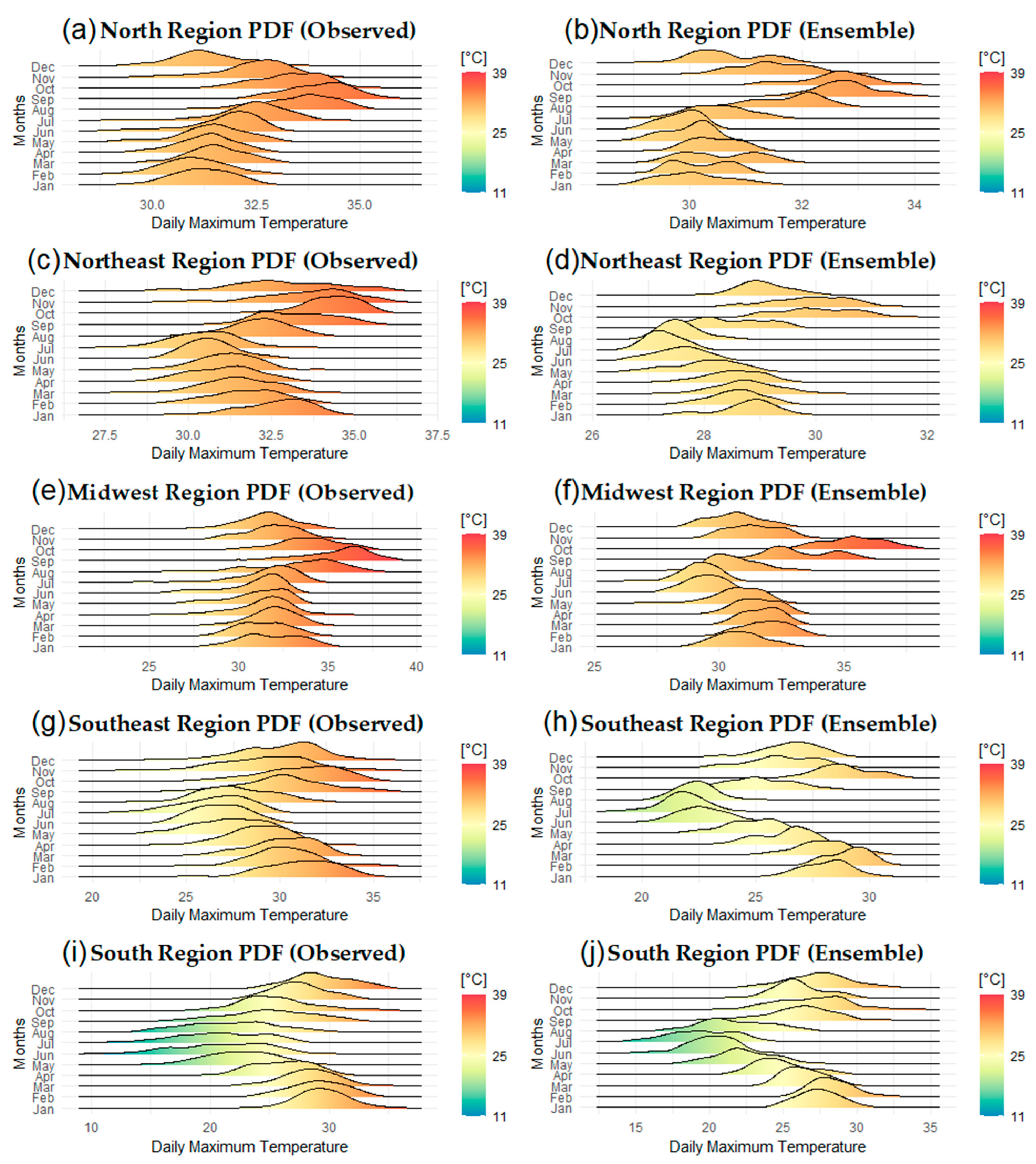



| Parameterization | |
|---|---|
| Cloud microphysics | [28,29] |
| Surface processes | IBIS-CPTEC |
| Short-wave radiation | CLIRAD-SW [30], modified by [31] |
| Long-wave radiation | CLIRAD-LW [32], modified by [31] |
| Planetary boundary layer | Moist diffusion scheme [33] |
| Deep convection | Revised and simplified by Arakawa-Shubert [34] |
| Aerosol optical depth | [35] |
| Thermal plume for convective boundary layer | [36] |
| Gravity wave drag | [37] |
| Solar Radiation (MJ/m2) | NO | NE | CO | SE | S |
| Observed | 16.8 | 19.5 | 17.9 | 18.0 | 16.3 |
| BAM-CLIM | 21.7 | 22.3 | 20.4 | 20.4 | 18.4 |
| BAM-CTE | 21.2 | 21.6 | 19.9 | 19.9 | 17.9 |
| BAM-ZERO | 22.5 | 22.9 | 21.3 | 21.3 | 19.2 |
| Maximum temperature (°C) | NO | NE | CO | SE | S |
| Observed | 32.0 | 32.0 | 32.1 | 29.1 | 25.5 |
| BAM-CLIM | 30.7 | 28.5 | 31.2 | 25.8 | 24.4 |
| BAM-CTE | 30.8 | 28.4 | 31.3 | 25.7 | 24.9 |
| BAM-ZERO | 30.9 | 28.5 | 31.3 | 26.0 | 24.6 |
| Average temperature (°C) | NO | NE | CO | SE | S |
| Observed | 27.2 | 26.5 | 26.0 | 23.2 | 20.3 |
| BAM-CLIM | 27.3 | 24.4 | 27.0 | 21.1 | 20.2 |
| BAM-CTE | 27.3 | 24.3 | 27.0 | 21.1 | 20.4 |
| BAM-ZERO | 27.5 | 24.4 | 27.2 | 21.3 | 20.3 |
| Minimum temperature (°C) | NO | NE | CO | SE | S |
| Observed | 22.4 | 21.0 | 20.0 | 17.2 | 15.0 |
| BAM-CLIM | 25.0 | 22.5 | 24.1 | 18.9 | 17.5 |
| BAM-CTE | 25.0 | 22.4 | 24.1 | 18.8 | 17.6 |
| BAM-ZERO | 25.2 | 22.5 | 24.4 | 19.2 | 17.6 |
| Wind velocity (m·s−1) | NO | NE | CO | SE | S |
| Observed | 0.9 | 1.6 | 1.1 | 1.3 | 1.8 |
| BAM-CLIM | 0.9 | 3.4 | 1.7 | 2.7 | 2.5 |
| BAM-CTE | 1.0 | 3.4 | 1.8 | 2.7 | 2.5 |
| BAM-ZERO | 1.0 | 3.4 | 1.8 | 2.8 | 2.6 |
Disclaimer/Publisher’s Note: The statements, opinions and data contained in all publications are solely those of the individual author(s) and contributor(s) and not of MDPI and/or the editor(s). MDPI and/or the editor(s) disclaim responsibility for any injury to people or property resulting from any ideas, methods, instructions or products referred to in the content. |
© 2023 by the authors. Licensee MDPI, Basel, Switzerland. This article is an open access article distributed under the terms and conditions of the Creative Commons Attribution (CC BY) license (https://creativecommons.org/licenses/by/4.0/).
Share and Cite
Herdies, D.L.; Silva, F.D.d.S.; Gomes, H.B.; Silva, M.C.L.d.; Gomes, H.B.; Costa, R.L.; Lins, M.C.C.; Reis, J.S.d.; Kubota, P.Y.; Souza, D.C.d.; et al. Evaluation of Surface Data Simulation Performance with the Brazilian Global Atmospheric Model (BAM). Atmosphere 2023, 14, 125. https://doi.org/10.3390/atmos14010125
Herdies DL, Silva FDdS, Gomes HB, Silva MCLd, Gomes HB, Costa RL, Lins MCC, Reis JSd, Kubota PY, Souza DCd, et al. Evaluation of Surface Data Simulation Performance with the Brazilian Global Atmospheric Model (BAM). Atmosphere. 2023; 14(1):125. https://doi.org/10.3390/atmos14010125
Chicago/Turabian StyleHerdies, Dirceu Luis, Fabrício Daniel dos Santos Silva, Helber Barros Gomes, Maria Cristina Lemos da Silva, Heliofábio Barros Gomes, Rafaela Lisboa Costa, Mayara Christine Correia Lins, Jean Souza dos Reis, Paulo Yoshio Kubota, Dayana Castilho de Souza, and et al. 2023. "Evaluation of Surface Data Simulation Performance with the Brazilian Global Atmospheric Model (BAM)" Atmosphere 14, no. 1: 125. https://doi.org/10.3390/atmos14010125
APA StyleHerdies, D. L., Silva, F. D. d. S., Gomes, H. B., Silva, M. C. L. d., Gomes, H. B., Costa, R. L., Lins, M. C. C., Reis, J. S. d., Kubota, P. Y., Souza, D. C. d., Melo, M. L. D. d., & Mariano, G. L. (2023). Evaluation of Surface Data Simulation Performance with the Brazilian Global Atmospheric Model (BAM). Atmosphere, 14(1), 125. https://doi.org/10.3390/atmos14010125








